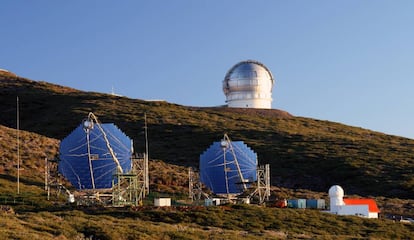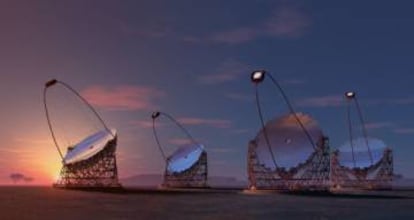World’s top telescopes face bureaucratic steeplechase in the Canaries
Local authorities and green groups place hurdles in the way of state-of-the-art astronomy projects

The astronomical observatories in Spain’s Canary Islands have just turned 30 years old, but they are still in top shape: scientists from across the world want to set up state-of-the-art telescopes there. Most recently, the Canaries have become the proposed alternative site for the colossal Thirty Meter Telescope (TMT); they will also host the European Solar Telescope and construction is underway on the first of 20 telescopes in a network that is known as the Cherenkov Telescope Array (CTA).

All of these facilities would add to the numerous astronomical devices already in place on the island of Tenerife and most particularly on La Palma, which sits on the western edge of the Spanish archipelago.
Normally, scientists have a hard time attracting funds and drumming up interest in their projects. But lately, astronomers’ biggest headaches have been caused by local opposition to their plans.
In La Palma, local officials have said that construction of the TMT could affect archeological sites on the island
“Any delay, any objection that is not well founded, can dissuade our international partners and cause a facility to be built elsewhere,” warned Carmen Vela, the Spanish state secretary for R&D, after a board meeting of the Canaries Astrophysics Institute (IAC). Based in Tenerife, this agency oversees the observatories in Tenerife and La Palma.
Vela expressed these concerns shortly after local officials had hindered construction of the first of the Cherenkov telescopes, a €200 million project due to go up at Roque de los Muchachos Observatory (La Palma).
“The administrative roadblock involving the first Cherenkov telescope is resolved. It’s true that it required a lot of talks, but the license has been granted,” said IAC director Rafael Rebolo. Yet only two months ago, Rebolo had stated that construction was in danger.

In 2015, Spain beat out Mexico in the race to host the Cherenkov Telescope Array, which will be the world’s biggest gamma-ray telescope in the world, able to analyze dark matter and some of the most violent objects in the universe, such as black holes. A few months later, the new winner of the Nobel Prize in Physics, Takaaki Kajita, laid the first stone and stated that a new Nobel winner might come out of the new facility.
But that was when the bureaucratic problems began. The town council of Garafía, where the telescopes are to go up, the IAC and the Cabildo of La Palma – the island’s top authority – all began arguing over the construction permits. The confrontation escalated, leading to angry statements in the press.
“Considering the trouble they bring and the benefits they leave here, maybe it’s just not worth it to have the observatory in town,” said the local urban planning councilor, Yeray Rodríguez. And the mayor, Martín Taño, added that “the IAC is no better than any resident of Garafía.”

The paperwork was finally sorted out, but there is great resentment against IAC in Garafía, the poorest municipality in the Canaries despite hosting the planet’s most cutting-edge scientific instruments.
Compounding this trouble is a recent complaint filed in court by a green group called Ben Magec, which says the project lacks an environmental impact assessment, according to its own criteria. Ben Magec has already tried to halt telescope projects on two occasions in the past, but its legal challenges have not prospered.
IAC chief Rebolo said that the Cherenkov project’s top brass is currently in La Palma to speak with government officials and see how the plan must be presented “to ensure that we scrupulously respect the laws and of course the environment, which has always been a matter of concern to this Institute.”
Any delay to science projects can cause enormous expenses that could render them non-viable
But Rebolo insisted that the paperwork should be dealt with as quickly as possible. “We will continue to ask them to be efficient,” he said, noting that science projects take up a lot of financial resources, and that any delay can cause enormous expenses that could render them non-viable.
It is precisely this sort of delay that could see the Thirty Meter Telescope end up in La Palma instead of in Hawaii, where it was originally planned for. Faced with local resistance there, scientists have already chosen the Canaries as their Plan B.
But the project could meet with similar problems in La Palma, where local officials have said that construction of the TMT could affect archeological sites on the island.
At the last meeting of the International Scientific Committee of the Canary Islands Observatories, President Oskar van der Lühe expressed concern over the administrative hurdles in the way of the Cherenkov project, and called on all relevant authorities to work to remove them, so that the international community will continue to want to set up telescopes in the Canary Islands.
The archipelago is also expecting to host the European Solar Telescope, a €200 million initiative for which the regional government of the Canaries has already made a €4.5 million appropriation.
English version by Susana Urra.









































